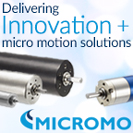 |
| June 26, 2018 | Volume 14 Issue 24 |
Motion Control News & Products
Designfax weekly eMagazine
Archives
Partners
Manufacturing Center
Product Spotlight
Modern Applications News
Metalworking Ideas For
Today's Job Shops
Tooling and Production
Strategies for large
metalworking plants
Linear guide system corrects misalignments
 Bishop-Wisecarver's UtiliTrak® linear guide system includes vee rails for precision and open rails for misalignment float to provide smooth and accurate motion on inaccurate structures. Because precise parallelism is difficult to achieve, it is not uncommon for mounting surfaces to be slightly out of parallel. UtiliTrak's design compensates for mounting errors and does not require absolute parallelism for accurate operation. Genius.
Bishop-Wisecarver's UtiliTrak® linear guide system includes vee rails for precision and open rails for misalignment float to provide smooth and accurate motion on inaccurate structures. Because precise parallelism is difficult to achieve, it is not uncommon for mounting surfaces to be slightly out of parallel. UtiliTrak's design compensates for mounting errors and does not require absolute parallelism for accurate operation. Genius.
Learn more.
Universal Robots emerges as preferred robotics platform for AI solutions at Automate 2024
 At North America's largest automation show (Chicago, May 6-9), cobot pioneer Universal Robots will redefine the frontiers of physical AI, showcasing how the "ChatGPT moment for robots" has arrived in a wide range of applications. Automate attendees will also experience how Universal Robots' newest cobot models, the UR20 and UR30, automate tasks with increased payload, reach, and torque.
At North America's largest automation show (Chicago, May 6-9), cobot pioneer Universal Robots will redefine the frontiers of physical AI, showcasing how the "ChatGPT moment for robots" has arrived in a wide range of applications. Automate attendees will also experience how Universal Robots' newest cobot models, the UR20 and UR30, automate tasks with increased payload, reach, and torque.
Learn more.
Multi-stage mini vacuum pumps: Max performance
 Designed to meet the demanding needs of industrial users, the CMS M series mini vacuum pump from COVAL combines robustness, performance, and modularity, offering an optimum solution for applications requiring high suction flow rates, such as gripping porous parts, emptying tanks, or material handling when integrated into vacuum grippers. Thanks to their ultra-compact design and optimized multi-stage Venturi system, these pumps guarantee powerful suction flows up to 19.42 SCFM, while reducing compressed air consumption in a compact footprint.
Designed to meet the demanding needs of industrial users, the CMS M series mini vacuum pump from COVAL combines robustness, performance, and modularity, offering an optimum solution for applications requiring high suction flow rates, such as gripping porous parts, emptying tanks, or material handling when integrated into vacuum grippers. Thanks to their ultra-compact design and optimized multi-stage Venturi system, these pumps guarantee powerful suction flows up to 19.42 SCFM, while reducing compressed air consumption in a compact footprint.
Learn more.
Choosing a stepper motor: PM or hybrid?
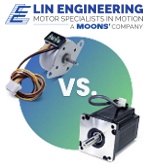 Lin Engineering stepper motors are widely used in various applications that require precise control of motion, such as in robotics, 3D printing, CNC machines, and medical equipment. There are two main types of stepper motors: permanent magnet (PM) and hybrid. Learn the differences, advantages, and when to use one type or the other.
Lin Engineering stepper motors are widely used in various applications that require precise control of motion, such as in robotics, 3D printing, CNC machines, and medical equipment. There are two main types of stepper motors: permanent magnet (PM) and hybrid. Learn the differences, advantages, and when to use one type or the other.
Read this informative Lin Engineering article.
Top Product: Integrated servo system is 20% smaller than standalone unit
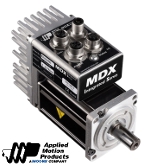 Applied Motion Products has introduced the MDX+ series, a family of low-voltage servo systems that integrate a servo drive, motor, and encoder into one package. This all-in-one drive unit is an ideal solution for manufacturers in logistics, AGV, medical, semiconductor, the solar industries, and many others.
Applied Motion Products has introduced the MDX+ series, a family of low-voltage servo systems that integrate a servo drive, motor, and encoder into one package. This all-in-one drive unit is an ideal solution for manufacturers in logistics, AGV, medical, semiconductor, the solar industries, and many others.
Read the full article.
Overhung load adaptors provide load support and contamination protection
 Overhung load adaptors (OHLA) provide both overhung radial and axial load support to protect electrified mobile equipment motors from heavy application loads, extending the lifetime of the motor and alleviating the cost of downtime both from maintenance costs and loss of production. They seal out dirt, grime, and other contaminants too. Zero-Max OHLAs are available in an extensive offering of standard models (including Extra-Duty options) for typical applications or customized designs.
Overhung load adaptors (OHLA) provide both overhung radial and axial load support to protect electrified mobile equipment motors from heavy application loads, extending the lifetime of the motor and alleviating the cost of downtime both from maintenance costs and loss of production. They seal out dirt, grime, and other contaminants too. Zero-Max OHLAs are available in an extensive offering of standard models (including Extra-Duty options) for typical applications or customized designs.
Learn more.
Why choose electric for linear actuators?
 Tolomatic has been delivering a new type of linear motion technology that is giving hydraulics a run for its money. Learn the benefits of electric linear motion systems, the iceberg principle showing total cost of ownership, critical parameters of sizing, and conversion tips.
Tolomatic has been delivering a new type of linear motion technology that is giving hydraulics a run for its money. Learn the benefits of electric linear motion systems, the iceberg principle showing total cost of ownership, critical parameters of sizing, and conversion tips.
Get this informative e-book. (No registration required)
New AC hypoid inverter-duty gearmotors
 Bodine Electric Company introduces 12 new AC inverter-duty hypoid hollow shaft gearmotors. These type 42R-25H2 and 42R-30H3 drives combine an all-new AC inverter-duty, 230/460-VAC motor with two hypoid gearheads. When used with an AC inverter (VFD) control, these units deliver maintenance-free and reliable high-torque output. They are ideal for conveyors, gates, packaging, and other industrial automation equipment that demands both high torque and low power consumption from the driving gearmotor.
Bodine Electric Company introduces 12 new AC inverter-duty hypoid hollow shaft gearmotors. These type 42R-25H2 and 42R-30H3 drives combine an all-new AC inverter-duty, 230/460-VAC motor with two hypoid gearheads. When used with an AC inverter (VFD) control, these units deliver maintenance-free and reliable high-torque output. They are ideal for conveyors, gates, packaging, and other industrial automation equipment that demands both high torque and low power consumption from the driving gearmotor.
Learn more.
Next-gen warehouse automation: Siemens, Universal Robots, and Zivid partner up
 Universal Robots, Siemens, and Zivid have created a new solution combining UR's cobot arms with Siemens' SIMATIC Robot Pick AI software and Zivid's 3D sensors to create a deep-learning picking solution for warehouse automation and intra-logistics fulfillment. It works regardless of object shape, size, opacity, or transparency and is a significant leap in solving the complex challenges faced by the logistics and e-commerce sectors.
Universal Robots, Siemens, and Zivid have created a new solution combining UR's cobot arms with Siemens' SIMATIC Robot Pick AI software and Zivid's 3D sensors to create a deep-learning picking solution for warehouse automation and intra-logistics fulfillment. It works regardless of object shape, size, opacity, or transparency and is a significant leap in solving the complex challenges faced by the logistics and e-commerce sectors.
Read the full article.
Innovative DuoDrive gear and motor unit is UL/CSA certified
 The DuoDrive integrated gear unit and motor from NORD DRIVE-SYSTEMS is a compact, high-efficiency
solution engineered for users in the fields of intralogistics, pharmaceutical, and the food and beverage industries. This drive combines a IE5+ synchronous motor and single-stage helical gear unit into one compact housing with a smooth, easy-to-clean surface. It has a system efficiency up to 92% and is available in two case sizes with a power range of 0.5 to 4.0 hp.
The DuoDrive integrated gear unit and motor from NORD DRIVE-SYSTEMS is a compact, high-efficiency
solution engineered for users in the fields of intralogistics, pharmaceutical, and the food and beverage industries. This drive combines a IE5+ synchronous motor and single-stage helical gear unit into one compact housing with a smooth, easy-to-clean surface. It has a system efficiency up to 92% and is available in two case sizes with a power range of 0.5 to 4.0 hp.
Learn more.
BLDC flat motor with high output torque and speed reduction
 Portescap's 60ECF brushless DC slotted flat motor is the newest frame size to join its flat motor portfolio. This 60-mm BLDC motor features a 38.2-mm body length and an outer-rotor slotted configuration with an open-body design, allowing it to deliver improved heat management in a compact package. Combined with Portescap gearheads, it delivers extremely high output torque and speed reduction. Available in both sensored and sensorless options. A great choice for applications such as electric grippers and exoskeletons, eVTOLs, and surgical robots.
Portescap's 60ECF brushless DC slotted flat motor is the newest frame size to join its flat motor portfolio. This 60-mm BLDC motor features a 38.2-mm body length and an outer-rotor slotted configuration with an open-body design, allowing it to deliver improved heat management in a compact package. Combined with Portescap gearheads, it delivers extremely high output torque and speed reduction. Available in both sensored and sensorless options. A great choice for applications such as electric grippers and exoskeletons, eVTOLs, and surgical robots.
Learn more and view all the specs.
Application story: Complete gearbox and coupling assembly for actuator system
 Learn how GAM engineers not only sized and selected the appropriate gear reducers and couplings required to drive two ball screws in unison using a single motor, but how they also designed the mounting adapters necessary to complete the system. One-stop shopping eliminated unnecessary components and resulted in a 15% reduction in system cost.
Learn how GAM engineers not only sized and selected the appropriate gear reducers and couplings required to drive two ball screws in unison using a single motor, but how they also designed the mounting adapters necessary to complete the system. One-stop shopping eliminated unnecessary components and resulted in a 15% reduction in system cost.
Read this informative GAM blog.
Next-gen motor for pump and fan applications
 The next evolution of the award-winning Aircore EC motor from Infinitum is a high-efficiency system designed to power commercial and industrial applications such as HVAC fans, pumps, and data centers with less energy consumption, reduced emissions, and reduced waste. It features an integrated variable frequency drive and delivers upward of 93% system efficiency, as well as class-leading power and torque density in a low-footprint package that is 20% lighter than the previous version. Four sizes available.
The next evolution of the award-winning Aircore EC motor from Infinitum is a high-efficiency system designed to power commercial and industrial applications such as HVAC fans, pumps, and data centers with less energy consumption, reduced emissions, and reduced waste. It features an integrated variable frequency drive and delivers upward of 93% system efficiency, as well as class-leading power and torque density in a low-footprint package that is 20% lighter than the previous version. Four sizes available.
Learn more.
Telescoping linear actuators for space-constrained applications
 Rollon's new TLS telescoping linear actuators enable long stroke lengths with minimal closed lengths, which is especially good for applications with minimal vertical clearance. These actuators integrate seamlessly into multi-axis systems and are available in two- or three-stage versions. Equipped with a built-in automated lubrication system, the TLS Series features a synchronized drive system, requiring only a single motor to achieve motion. Four sizes (100, 230, 280, and 360) with up to 3,000-mm stroke length.
Rollon's new TLS telescoping linear actuators enable long stroke lengths with minimal closed lengths, which is especially good for applications with minimal vertical clearance. These actuators integrate seamlessly into multi-axis systems and are available in two- or three-stage versions. Equipped with a built-in automated lubrication system, the TLS Series features a synchronized drive system, requiring only a single motor to achieve motion. Four sizes (100, 230, 280, and 360) with up to 3,000-mm stroke length.
Learn more.
Competitively priced long-stroke parallel gripper
 The DHPL from Festo is a new generation of pneumatic long-stroke grippers that offers a host of advantages for high-load and high-torque applications. It is interchangeable with competitive long-stroke grippers and provides the added benefits of lighter weight, higher precision, and no maintenance. It is ideal for gripping larger items, including stacking boxes, gripping shaped parts, and keeping bags open. It has high repetition accuracy due to three rugged guide rods and a rack-and-pinion design.
The DHPL from Festo is a new generation of pneumatic long-stroke grippers that offers a host of advantages for high-load and high-torque applications. It is interchangeable with competitive long-stroke grippers and provides the added benefits of lighter weight, higher precision, and no maintenance. It is ideal for gripping larger items, including stacking boxes, gripping shaped parts, and keeping bags open. It has high repetition accuracy due to three rugged guide rods and a rack-and-pinion design.
Learn more.
All-time record smashed: Volkswagen makes history with the all-electric I.D. R at Pikes Peak

[All images © 2018 Copyright Volkswagen]
Volkswagen and its special, all-electric I.D. R Pikes Peak racer have made history at the finals of the Pikes Peak International Hill Climb held in Colorado this past Sunday, June 24.
Driving the 500-kW racecar, Romain Dumas defeated a field including cars with conventional drivetrain technology. In doing so, Dumas not only broke the previous record for electric vehicles, but also bettered Sébastien Loeb's all-time speed record from 2013 -- by a full 16 seconds. Dumas' new record of 7m 57.148s is now top of the list of Pikes Peak champions, which includes such acclaimed drivers as Loeb, Walter Röhrl, Michèle Mouton, Stig Blomqvist, Nobuhiro Tajima, and Rod Millen and his son Rhys.
"With a combination of outstanding engineering skills, passion, and commitment, the team has managed to create a fantastic racing car in just eight months," said Dr. Frank Welsch, Member of the Board of Management of the Volkswagen Passenger Cars brand with responsibility for Technical Development. "The Volkswagen I.D. R Pikes Peak has now set the fastest time in the history of this hill climb, which spans more than 100 years. That speaks volumes for electric mobility."
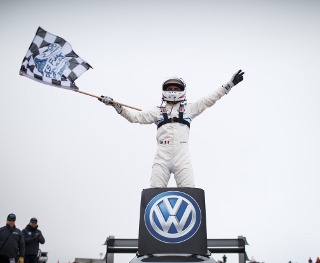
Volkswagen I.D. R Pikes Peak driver Romain Dumas claims victory at the 2018 event.
Held in a Rocky Mountains area just 16 miles west of Colorado Springs, the race is a climb of 4,720 ft from the start at Mile 7 on Pikes Peak Highway to the finish at 14,110 ft on grades averaging 7.2%. It is 12.42 miles, 156 corners, and just one attempt. Romain Dumas claimed his fourth overall victory at the Pikes Peak International Hill Climb this year, which has now been held 96 times since 1916.
VIDEO: VW's record run.
With the I.D. R Pikes Peak, Volkswagen has created an extraordinary racing car, specifically tailored to the demands of the most famous of hill climbs: a combination of minimum weight, as much downforce as possible, and maximum power -- all coalescing to achieve the best possible performance. Including its battery cells, the I.D. R Pikes Peak weighs less than 2,425 lb. When evaluating performance, Volkswagen employed simulation software to calculate exactly how to achieve the optimum in energy demand and performance for the record attempt on the famous racecourse.
"There is one big advantage of having an electric car in the Pikes Peak International Hill Climb -- the power remains constant over the entire 20-kilometer route," said Dumas. "By contrast, vehicles fitted with combustion engines lose a significant amount of power in the thin mountain air."
With its two electric motors, which together generate 671 hp, the I.D. R avoids the cooling issues that combustion-engine vehicles face. This made it possible to reduce the size of the intakes in the chassis, which are traditionally aerodynamic drawbacks.
As far as aerodynamics, the key was to compensate for the loss of downforce caused by the thin air on the mountain. The design result could be seen from afar: the flat, streamlined chassis and huge rear wing.
"The altitude on Pikes Peak means that the air we are driving through is on average 35 percent thinner. As a result, we lose 35 percent of our downforce compared to a racetrack at sea level. The huge rear wing allows us to compensate for some of this lost downforce," said Willy Rampf, technical consultant to the project with years of Formula 1 experience. "The imaginative aerodynamic development means that we still achieve maximum downforce greater than the weight of the car during the hill climb."
Volkswagen Motorsport used a half-scale model to test a host of different variants of the Pikes Peak racer in the wind tunnel. The final touches were then put to a full-size chassis on the rolling-road wind tunnel in the Porsche development center in Weissach, Germany.
New components were often produced in quick time on a 3D printer. "We printed about 2,000 parts. In doing so, we saved a lot of time," said Dr. Hervé Dechipre, who, as a CFD engineer at Volkswagen Motorsport, is responsible for the aerodynamics on the I.D. R Pikes Peak.
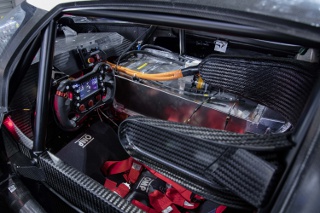
Inside the driver cockpit.
Lithium-ion batteries are used as the energy storage system, similar to production EVs, as their power density is the crucial factor for the system when producing high voltage. Roughly 20 percent of the electric energy required is generated during the drive, so the key here is energy recovery. When braking, the electric motors act as generators, converting some of the braking energy into electricity and feeding this into the battery.
Volkswagen also struck out in a new direction when it came to the car's charging technology. The goal was to charge the car as quickly as possible with minimum environmental impact. The time for charging was defined by the regulations: In case of the race being suspended, it must be possible to completely charge the car in under 20 minutes. The electricity required was provided by generators at the foot of Pikes Peak. Glycerol, which in chemical terms is a sugar alcohol, was selected as the generator fuel. A by-product of the manufacture of biodiesel, Glycerol combusts with virtually no harmful exhaust fumes or residues. Glycerol itself is non-toxic and is even permitted as an additive in the food and cosmetics industries.
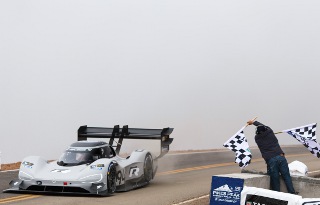
Volkswagen's latest Pikes Peak project started on Oct. 18, 2017, meaning very little time was allotted for the development of the thoroughbred prototype, including innovative fully electric drive technology, specific demands on the batteries, aerodynamics, and chassis. The effort was centered at the VW Motorsports facility in Hannover, not too far from VW's headquarters in Wolfsburg, Germany.
Volkswagen has had some strong partners on its side for the record attempt on Pikes Peak this year, notably Volkswagen R, ANSYS, Michelin, Integral e-drive, and OMP. ANSYS made a vital contribution to the success of the project by providing support with the software simulations.
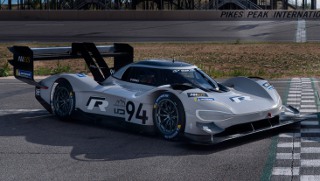
Volkswagen last entered the Pikes Peak hillclimb in 1987 with a particularly noteworthy dual-engine Golf that generated an impressive 652 hp. However, the Wolfsburg-based manufacturer narrowly missed out on success.
Dumas' last winning Pikes Peak run was in 2016 driving a Honda-powered Norma M20 RD Limited up the course in less than 9 minutes -- at the time, it was only the second ride in the event's history to break that mark.
Source: Volkswagen Motorsport
Published June 2018
Rate this article
View our terms of use and privacy policy
